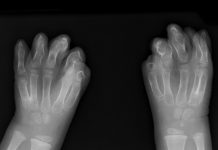Torticollis is the name given to the dystonic condition marked by an abnormal or asymmetrical positioning of one’s neck or the head. Terms like wry neck and Loxia are also used to refer to this condition.
In simpler terms, the condition includes a broad category of tension, flexion or extension of the muscles of the neck that goes beyond the normal position. Whatever the kind of tension, it causes the neck of the affected individual to twist and hence causes a tilt of the head to either side.
 The type of torticollis can be broadly classified depending upon the positioning of the head and the neck as follows:
The type of torticollis can be broadly classified depending upon the positioning of the head and the neck as follows:
- Laterocollis: This is when the head is tipped towards the shoulder of the individual
- Rotational Torticollis: When the head rotates with the longitude axis of the person
- Retrocollis: When the neck and the head are extended/ hyper extended backwards
- Anterocollis: The flexion of the head and neck forward
The combination of these individual movements has also been observed in quite a lot of cases.
Causes
There are a few different reasons listed as the cause of torticollis. They are as follows:
- Family history:It is seen that a lot of individuals who have a family history of torticollis end up having the condition themselves.
- Congenital: Birth trauma and the mal-position in the uterus are two of the reasons which are considered to be the cause of congenital torticollis i.e. developed from the time of birth.
- Acquired: An individual can acquire torticollis for reasons other than congenital. Varied sorts of damages to the nervous system, the upper spine or the muscles of the neck can result in development of torticollis. Scarring or diseases like cervical vertebrae, tonsillitis, cerebella tumours can be such causes.
Symptoms
If an individual seems to display multiple of the below listed symptoms it may be a pointer towards torticollis:
- Difference in the height of the shoulders
- Stiffness in the muscles of the neck, or any swelling
- Headaches and head tremors
- A limited range for the movement or motion of the head
- Constant neck pain
Treatment
The treatment for torticollis may vary depending upon the causes of the flexion, tension or extension. Here is a list of a few treatments that are effective in treating the condition:
- One of the most effective and most widely used methods to treat torticollis is applying heat to the cervical spine (or affected organ) and treating the neck and the head with regular message sessions to relieve the pain.
- A combination of stretching exercises may be used to help cure the muscle spasms.
- The use of neck braces to keep the muscles in place and tune them accordingly is also a widely used way of treating torticollis.
- When torticollis is congenital, the medical personnel rely on passive stretching and positioning of the neck of the infant.
- Medications may be used in addition to the stretching and other therapeutic treatments.
- Surgery also corrects the neck muscle but is pursued only when all other methods fail.













